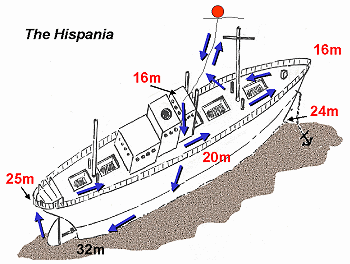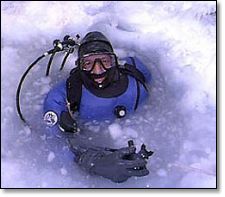Reducing the Risk of DCI
Decompression Illness (DCI) is unpredictable. A diver may follow the same dive profile as their buddy, within the dive tables and suffer DCI, whereas the buddy may be fine. Unfortunately, there is no way of eliminating the risk of DCI if you dive! However, there are ways that you can reduce the risk.
Plan the dive and dive the plan
Don’t dive if you’re not feeling 100%
Include safety margins
Always dive within your limits
Restrict your ascents
Avoid saw tooth and rectangular dive profiles
Abort the dive if necessary
Slow your ascent
Relax after the dive
Extend your surface interval between dives
Include rest days
Carefully plan deep dives
Avoid diving when dehydrated
Keep warm
Avoid exposure to high altitudes after diving
Increase your fitness
Plan the dive and dive the plan

Always plan your diving carefully and stick to the dive plan. Make sure that you know how to plan a dive and use the dive tables correctly. It is essential that you carry an accurate and reliable means of measuring your maximum depth and total dive time. A computer and/ or a depth gauge with a maximum depth indicator and a bottom timer are crucial to your dive.
Don’t dive if you’re not feeling 100%
Many factors can influence the development and potential severity of Decompression Illness. Any sign of illness should be taken as a warning that DCI may be more likely, or may indicate an existing episode of DCI.
Include safety margins
The diving tables used by recreational SCUBA divers were originally designed for young, fit, male military Navy divers. Pushing the tables to their limits, lack of fitness, chronic illnesses (e.g. chest/ ear infections), previous decompression illness, physical injury and obesity can all increase the risk of suffering from DCI. Women and divers beyond middle age are also at a higher risk of suffering from DCI. By building in additional safety margins to the dive plan and avoiding dives that require decompression stops, the chances of suffering from DCI can be reduced.
Always dive within your limits
It is important that you are aware of the type of experience required for a specific dive site / holiday. Anxiety about a particular dive is typically heightened during the dive, particularly at depth with the effects of nitrogen narcosis. It is essential, therefore, that the dive plan is within your limits of experience to reduce the risk of an incident which could result in DCI.
Restrict your ascents
Multiple ascents during the dive increases the risk of DCI. Each time you re-descend additional nitrogen may be added to the bubbles remaining from the previous ascent and these bubbles will become even larger during the next ascent. If you have ascended for any reason during a dive and then re-descended, it is important that you considerably reduce your dive time to decrease the risk of DCI.
Avoid saw tooth and rectangular dive profiles
Dive profiles in which you re-descend (e.g. sawtooth), remain at the same depth (e.g. rectangular) or work progressively deeper throughout the dive increase the risk of DCI. By choosing a profile where you spend only a short time at the maximum depth at the beginning of the dive followed by a gradual ascent throughout the rest of the dive, will reduce the risk of you suffering from DCI.

Example of dive profile that may reduce risk of DCI.

Example of dive profile more likely to result in DCI.
Abort the dive if necessary
If the dive plan breaks down during the dive (e.g. currents force you deeper than planned) or you and / or your buddy are uneasy about the situation then you must be willing to abort the dive and ascend immediately to the surface in a controlled manner.
Slow your ascent
Imagine removing the lid from a freshly shaken bottle of beer or carbonated water. Whilst the lid was on the bottle the drink was held under pressure. When removed the ambient pressure drops and the gas causes the drink to froth out of the bottle. Similarly, a diver that ascends too rapidly can cause the nitrogen in the blood system to form bubbles in areas where they can become trapped and cause DCI. It is recommended, therefore, that you follow the ascent rate on your dive tables, or for additional safety, you ascend slightly earlier from your dive to include the additional time for a slower ascent than prescribed by the tables.
Relax after the dive
 Exercise increases the chance of bubble formation by agitating the nitrogen in your blood and tissues.
Exercise increases the chance of bubble formation by agitating the nitrogen in your blood and tissues.
Take it easy and refrain from any strenuous exercise (e.g. aerobics, gym etc.) after the dive.
Extend your surface interval between dives
Bubble formation occurs far sooner on the second dive, as the nitrogen is quickly added to any bubbles remaining from the previous dive. Either allow longer between dives to off-gas or dive well within the limits of the tables or computers on the second dive to reduce the risk of DCI. Make sure your deepest dive is the first dive of the day and subsequent dives are progressively shallower.
Include rest days
If you are planning a week’s diving holiday, then it is recommended that you restrict your number of dives each day to a maximum of 3 and that you have a rest day (i.e. no dives for 24 hours) every 3 to 4 days.
Carefully plan deep dives
The risk of DCI increases disproportionately with depth. At depths greater than 30m, factors such as nitrogen narcosis and cold can cause problems for the diver which can escalate into major incidents, such as uncontrolled ascents which may cause DCI. If the deep dive, however, can not be avoided then it is recommended that the dive must be carefully planned and executed by divers who are experienced and have built up to the dive by diving progressively deeper in the days prior to the deep dive. The chances of suffering from DCI can also be reduced by shortening the dive time.
Avoid diving when dehydrated
Dehydration makes you more prone to DCI. Make sure you drink plenty of fluids (e.g. water, isotonic drinks) that hydrate your body, but restrict your intake of fluids that dehydrate your body (e.g. alcohol, tea, coffee) before your dive. Note: Excess alcohol the night before will lead to dehydration!
Keep warm
 The release of nitrogen from tissues in the body can also be slowed by a reduced body temperature, so on surfacing when the body starts to warm, the nitrogen is released at a faster pace and bubbles may develop.
The release of nitrogen from tissues in the body can also be slowed by a reduced body temperature, so on surfacing when the body starts to warm, the nitrogen is released at a faster pace and bubbles may develop.
Winter diving in Scotland can not always be the warmest of experiences! It is very important, therefore, to stay warm before and during the dive.
Avoid exposure to high altitudes after diving
 If sufficient bubbles are allowed to form on a dive, then you can suffer from DCI by flying or driving* at altitude too soon after diving as the existing bubbles will expand and new bubbles will form. It is recommended that you do not fly for 12 – 24 hours after your last dive and that you alter your dive plan to compensate for significant altitude changes on your drive home from the dive site.
If sufficient bubbles are allowed to form on a dive, then you can suffer from DCI by flying or driving* at altitude too soon after diving as the existing bubbles will expand and new bubbles will form. It is recommended that you do not fly for 12 – 24 hours after your last dive and that you alter your dive plan to compensate for significant altitude changes on your drive home from the dive site.
* Driving from Oban, a popular dive site on the west coast of Scotland to Glasgow involves ascending to an altitude of over 1000 ft at the “Rest and be Thankful” and it is, therefore, essential that you consider this when planning your dives to reduce the risk of DCI.
Increase your fitness
It is essential that you are medically fit to dive and that you are examined by a doctor, qualified in conducting diving medicals at regular intervals. Always check safe dosage levels if taking medication whilst diving.
Dont dive against medical advice! Many deaths have involved those who had previously been advised to stop.